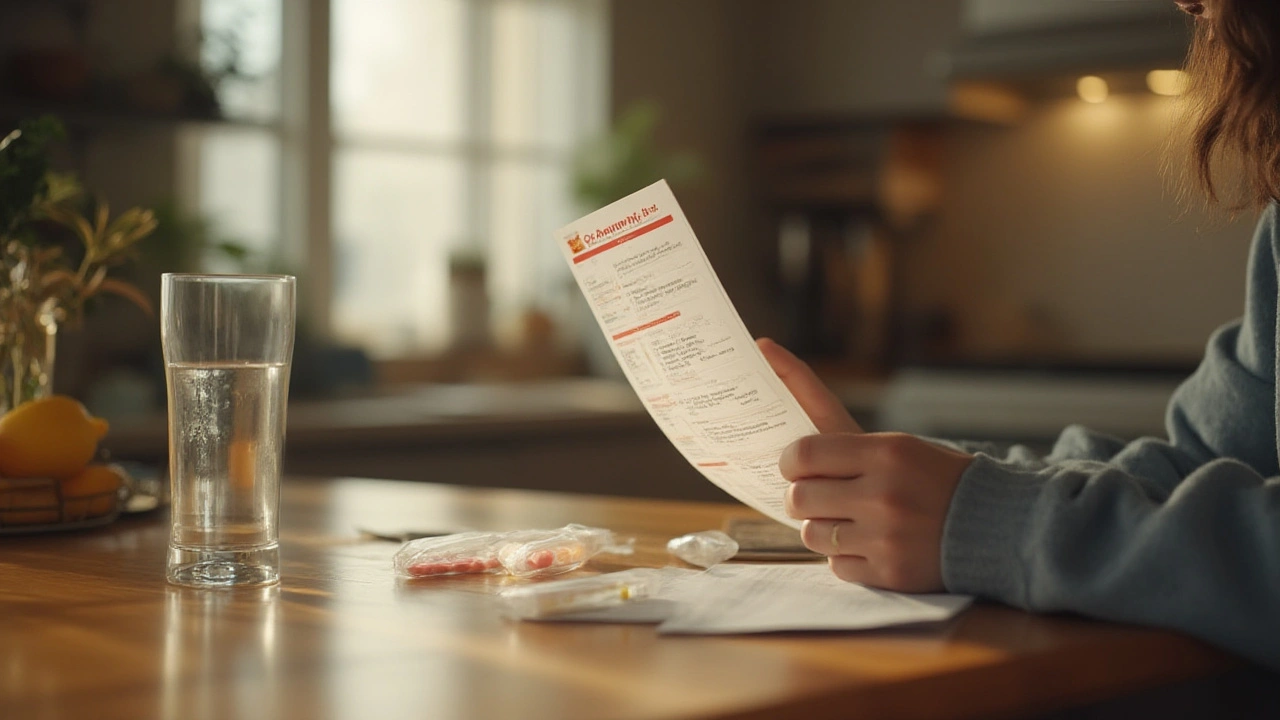Imagine waking up with a fever, your throat feels like sandpaper, and your head pounds every time you swallow. You power through your day, convincing yourself it will go away, only to find yourself in the doctor's office with a prescription for a name you might stumble over—co-amoxiclav. You've probably seen it in your medicine cabinet or heard stories about it, but few know why this antibiotic is in a class of its own. The truth? Co-amoxiclav packs a punch that basic penicillin can't match, fighting some of the nastiest bacteria modern medicine faces.
What Is Co-Amoxiclav and How Does It Work?
Co-amoxiclav sounds fancy, but it’s just a mix of two main ingredients: amoxicillin and clavulanic acid. Here’s why that matters. Amoxicillin is a tried-and-tested antibiotic, often given on its own for bacterial infections. Trouble is, many bacteria have figured out how to break down amoxicillin using enzymes called beta-lactamases. That’s where clavulanic acid comes in—it acts as a shield, blocking the bad guys so the antibiotic can actually work.
This tag-team approach means co-amoxiclav isn’t just fighting regular infections. It’s used when bacteria are resistant, making it the go-to choice for doctors who’ve seen other antibiotics fail. Think stubborn sinus infections that drag on for weeks, chest infections that knock people off their feet, or even skin wounds that look red, hot, and angry. Each year, millions of people are prescribed co-amoxiclav for conditions like pneumonia, urinary tract infections, dental abscesses, and some cases of animal bites.
Here’s an interesting tidbit: A large UK study in 2023 showed co-amoxiclav was prescribed in about 18% of all antibiotic courses given out that year—proof that it’s trusted, but not handed out like candy.
This antibiotic comes in a few forms: tablets, chewables, and liquid. Kids often get the suspension, which has a sugary taste anyone who’s ever bribed a child with yogurt will recognize. Adults usually get tablets (sometimes as big as your fingernail), to be taken every 8 or 12 hours, depending on the length and strength your doctor decides.
If you’re ever confused about why you’re being given co-amoxiclav instead of simple amoxicillin, chances are your doctor suspects those beta-lactamase enzymes might be causing trouble. They’re using this combo drug as a smart way to outsmart the bacteria’s defenses.
What Infections Does Co-Amoxiclav Treat?
This is where co-amoxiclav really flexes its muscles. It’s not a one-trick pony. Unlike antibiotics that only work in the throat or lungs, co-amoxiclav is used for a bunch of different problems. Docs often reach for it when infections are stubborn or when lab results show resistance to simpler antibiotics.
- Chest infections—Think pneumonia, bronchitis, or serious flare-ups in people with COPD. The added clavulanic acid helps clear bacteria that might laugh at regular amoxicillin.
- Sinus and ear infections—It’s prescribed when mild treatments flop, or when mucus turns green and pressure builds in your head like a balloon.
- Urinary tract infections—Especially in cases where standard drugs fail or if people have complicated histories.
- Skin and soft tissue infections—Such as infected cuts, nasty bites, diabetic foot ulcers, or wounds after minor surgeries.
- Dental abscesses—That jaw pain and swelling? When drainage and a simple antibiotic don’t cut it, dentists pull out co-amoxiclav.
Less commonly, co-amoxiclav is given for bone infections, joint infections, and sometimes for preventing infection during surgery. Of course, your doctor won’t give it out unless it’s likely you need both the amoxicillin and the clavulanic acid twist.
Here’s a cool fact: Veterinary clinics prescribe it for pets too—think dogs with infected bites, or cats with abscesses after fights. The dosing is very different, but the science is the same.
This drug isn’t for viral infections, though. No amount of co-amoxiclav will help with the flu, COVID-19, or a typical cold. That’s why doctors often wait for clear signs of a bacterial problem—like a high fever, pus, or a suspected resistant organism—before writing it up. Don’t be surprised if the doctor says no, even if you’re feeling lousy. It’s about targeting the right bugs with the right tools.

Side Effects: What To Expect (And When To Worry)
Let’s be honest: no medication is totally side-effect-free. While most folks handle co-amoxiclav well, some side effects pop up more than others. These can run from the mild (think stomach rumbles) to the rare but serious.
- Most common problem? Gut upset. Nausea, diarrhea, or a weird taste in the mouth. About 1 in 10 people get some tummy trouble. Taking the dose with food can help a lot.
- Rash—Sometimes a mild, red, blotchy rash appears, especially in kids. Amoxicillin in general can cause this, but people with mononucleosis (“mono”) are almost guaranteed a rash if given this drug. If the rash blisters or spreads rapidly, get help fast—it could be an allergic reaction.
- Thrush (oral or vaginal)—Antibiotics wipe out the good bacteria along with the bad, and yeast can sneak in. That’s why you may notice white patches in your mouth or sudden itching down below during a course.
- Rare but real problems—Liver irritation (yellowing of skin/eyes), severe allergic reactions (swelling, breathing difficulty), or bloody diarrhea are huge red flags. These need urgent attention. Liver reactions are seen in about 1 in 10,000 adults; while that’s rare, it’s real.
An interesting 2022 European Medicines Agency review found co-amoxiclav to be among the top five antibiotics linked with antibiotic-associated diarrhea, mostly because it’s powerful enough to disrupt the gut’s delicate balance. Probiotic yogurts get recommended a lot for this reason, but the science is mixed—plain food and hydration go a long way.
If you’re on birth control pills, you might have heard antibiotics can mess with them. The evidence for co-amoxiclav is shaky, but doctors still recommend backup contraception during and right after a course—better safe than hunting for Plan B.
Dosage Tips and How to Take Co-Amoxiclav Safely
You’d think taking antibiotics is straightforward, but missing doses or stopping early is one of the top reasons bacteria get clever and fight back. Here are a few rules that matter more than people realize:
- Always take the med exactly as prescribed—if it’s every 8 hours, stick to that. Smartphone alarms make life easier here.
- Finish the course—even if you feel better. Stopping halfway lets the toughest bacteria survive and regroup for next time.
- Swallow tablets whole with water; don’t crush them unless told to (some aren’t designed to be split or mashed up).
- Liquid co-amoxiclav needs a good shake before each dose. If you ever mix it yourself, check the bottle for how long it lasts in the fridge—usually 7 days (never weeks!).
- Drink plenty of water. This helps flush the drug through your kidneys and prevents crystals from forming in your pee (a rare, weird side effect with amoxicillin-based drugs).
- If you forget a dose within a couple hours, take it. If it’s almost time for the next dose, skip the one you missed—never double up.
- Alcohol won’t interact badly with co-amoxiclav, but heavy drinking while sick doesn’t do your body any favors.
- Let your doc know about kidney or liver trouble—dosing will need a careful tweak in those cases.
A lot of people love to ask: can I reuse left-over antibiotics for similar symptoms? The answer’s always no. You need the right dose, at the right time, and leftover pills might have lost their kick, or worse, cause bacteria to learn new tricks in resistance. Throw unused meds away safely—most pharmacies have take-back programs.
Got that metallic taste in your mouth? It’s a known quirk, especially when taking the liquid form. Sucking on sugar-free candy or rinsing your mouth can help if it bothers you.

When Should You Ask For Co-Amoxiclav—And When Should You Skip It?
It’s easy to think of antibiotics as magic bullets, but they don’t cure everything. Doctors weigh a ton of things before choosing co-amoxiclav. Ask questions if you’re not sure you need it—good communication can stop overuse and those “superbug” headlines you keep seeing.
Here’s a handy table for when co-amoxiclav is likely—and unlikely—to be useful:
| Condition | Co-amoxiclav Needed? | Why? |
|---|---|---|
| Strep throat | Rarely | Simple penicillin usually works better; co-amoxiclav is overkill |
| Bronchitis with green sputum | Sometimes | If at risk for resistant bugs or with other illnesses |
| Sinus infection over 10 days | Often | Bacterial cases may need it after milder drugs fail |
| Dog/cat bite | Yes | Covers a wide mix of bacteria found in animal mouths |
| Common cold/flu | No | Viruses don’t respond to antibiotics at all |
| Dental abscess | Yes | If standard amoxicillin fails or infection is severe |
If you’ve had allergic reactions to penicillins (think hives, swelling, breathing issues), steer clear. Your doctor will pick something safer. If you’re not sure about your allergy history, pharmacists and docs can help sort it out—don’t risk it.
Pregnant or breastfeeding? Co-amoxiclav is generally safe, but always check. It does pass into breastmilk, so babies may get mild diarrhea, but real problems are rare. There’s still much doctors are learning about antibiotics during pregnancy, but this combo has decades of track record.
Avoid using leftovers or sharing with family “just in case”. That’s a recipe for masking symptoms and causing more resistant bugs down the road.

